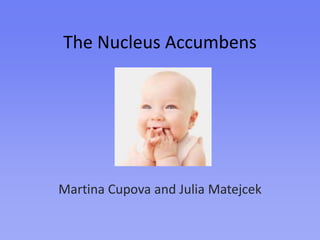Nucleus Accumbens
•Descargar como PPTX, PDF•
1 recomendación•2,551 vistas
Denunciar
Compartir
Denunciar
Compartir

Recomendados
Más contenido relacionado
La actualidad más candente
La actualidad más candente (20)
The Human Connectome Project multimodal cortical parcellation: new avenues fo...

The Human Connectome Project multimodal cortical parcellation: new avenues fo...
Similar a Nucleus Accumbens
Similar a Nucleus Accumbens (20)
#36421 Topic Discussion 7Number of Pages 1 (Double Spaced).docx

#36421 Topic Discussion 7Number of Pages 1 (Double Spaced).docx
#36417 Topic Discussion 3Number of Pages 1 (Double Spaced).docx

#36417 Topic Discussion 3Number of Pages 1 (Double Spaced).docx
#36420 Topic Discussion 6Number of Pages 1 (Double Spaced).docx

#36420 Topic Discussion 6Number of Pages 1 (Double Spaced).docx
Nucleus Accumbens
- 1. The Nucleus Accumbens Martina Cupova and Julia Matejcek
- 2. Location in the Brain Midbrain, at the top of the brainstem. Works in tandem with the other centers involved in pleasure. Ventral tagmental area Prefrontal cortex
- 4. Function Part of the reward circuit. Two neurotransmitters: dopamine (desire) seretonin (satiety and inhibition) Maintains motivation. Controls feeding, sexual, reward, stress-related, and drug self-administration behaviours.
- 6. Results and Findings The rats became addicted to the rush of pushing the lever. They preferred it to eating and drinking – some of the rats even starved themselves. Many even ran across the electrified grid to reach the lever.
- 8. Results and Findings Switching the stimulus activated the hippocampus, the nucleus accumbens, and then the hippocampus again. This brain pattern provides a way to consistently predict memory formation. The nucleus accumbens is involved in processing not only rewards, but also novel information. May influence further processing by the hippocampus.
- 9. Schaepfer et al. Aim: try to treat severely depressed patients who had not responded to alternative treatments using deep brain stimulation.
- 10. Procedure Implanted the electrodes in the nucleus accumbens of the patients. Turned on the stimulator to send electrical signals to that part of the brain. Turned the stimulator on and off over a period of weeks and tracked development of symptoms by questionnaires.
- 11. Results and Findings Most patients reported positive effects instantaneously – they had newfound motivation. Most patients improved only in the short-term – they had instant results that did not last. Deep brain stimulation of the nucleus accumbens did not treat depression in the long term.
- 13. ADHD – motivation is impaired.
- 15. Works Cited cont. New Way To Fight Cocaine Addiction Discovered. (2009, April 2). Science Daily. Retrieved from University of California - Irvine website: http://www.sciencedaily.com Scientists Discover Alterations in Brain’s Reward System Related to Attention-Deficit/hyperactivity Disorder. (n.d.). Science Daily. Retrieved from Universitat Autònoma de Barcelona website: http://www.sciencedaily.com Singer, E. (2007, April 26). Brain Electrodes Help Treat Depression. In Technology Review. Retrieved from Massachusetts Institute of Technology website: http://technologyreview.com Surprise! Neural Mechanism May Underlie an Enhanced Memory for the Unexpected. (2010, February 25). Science Daily.